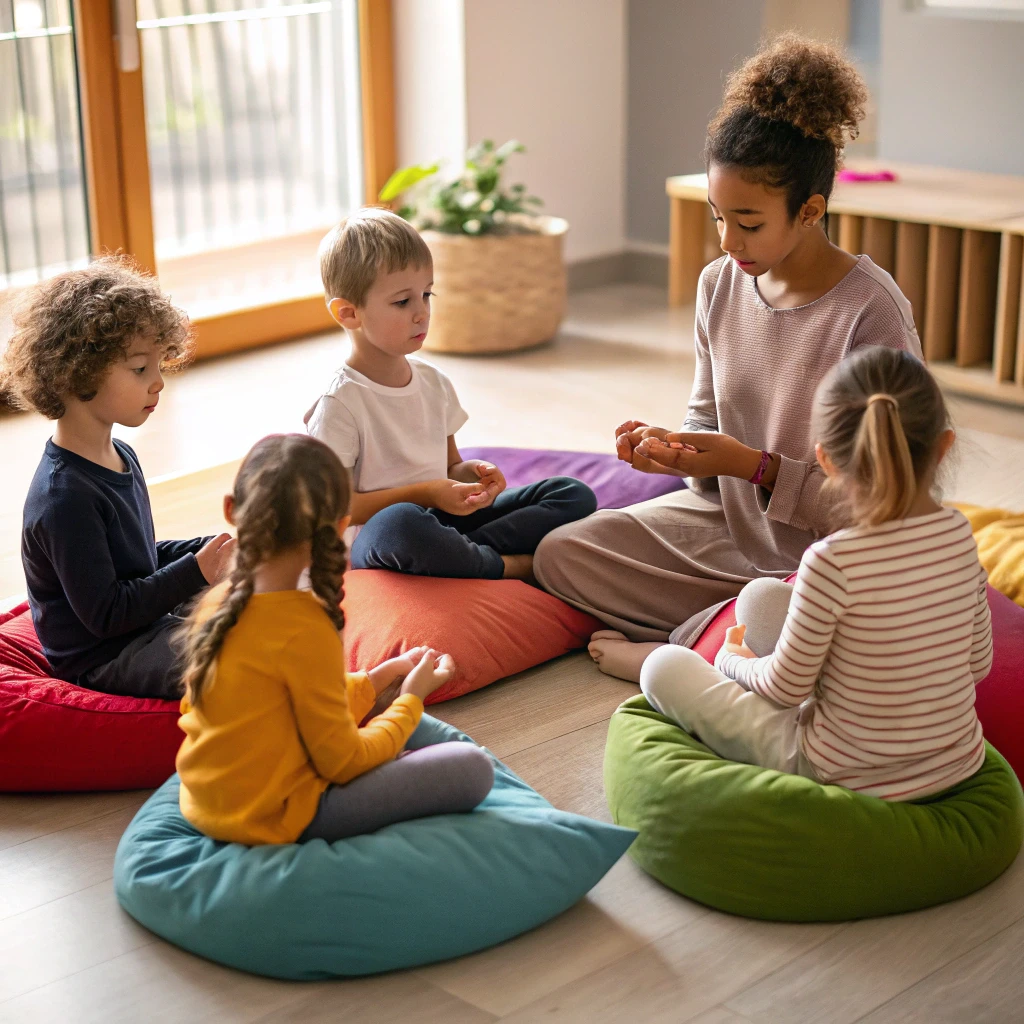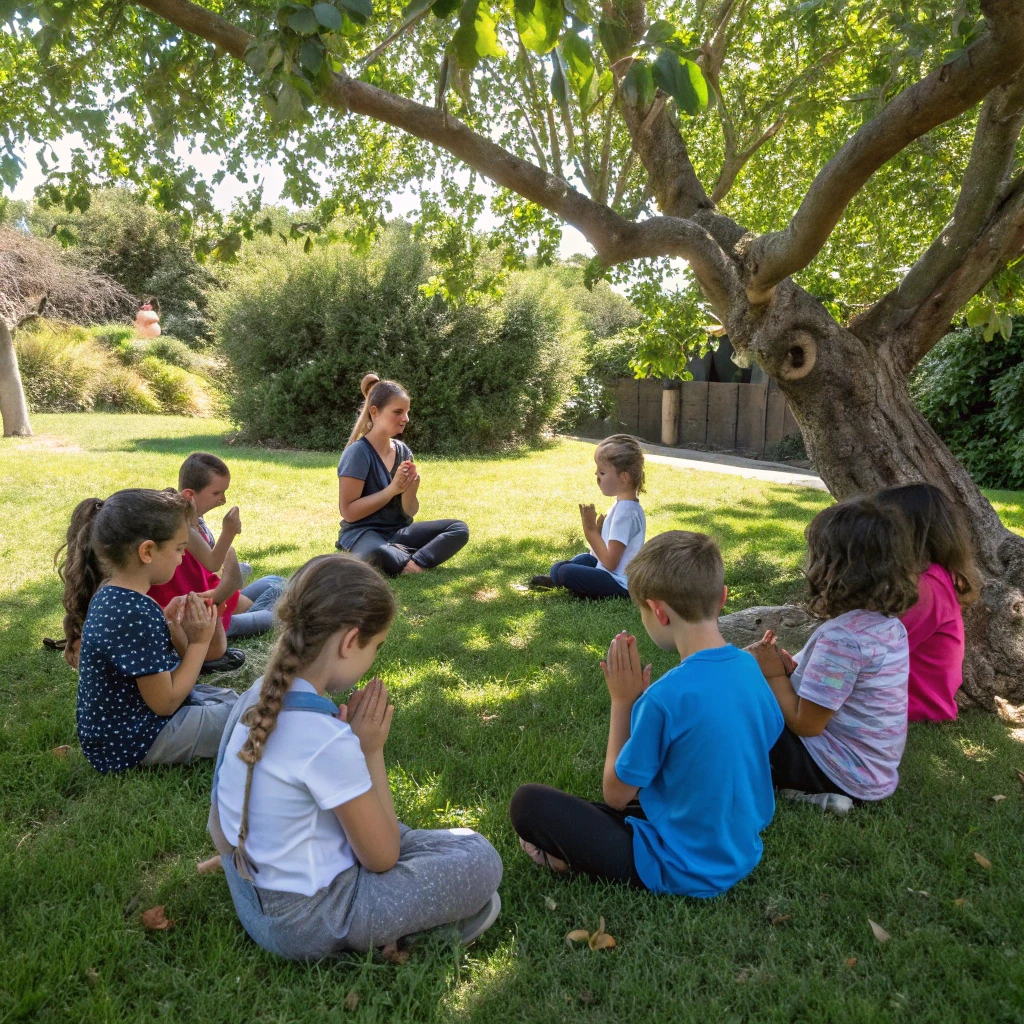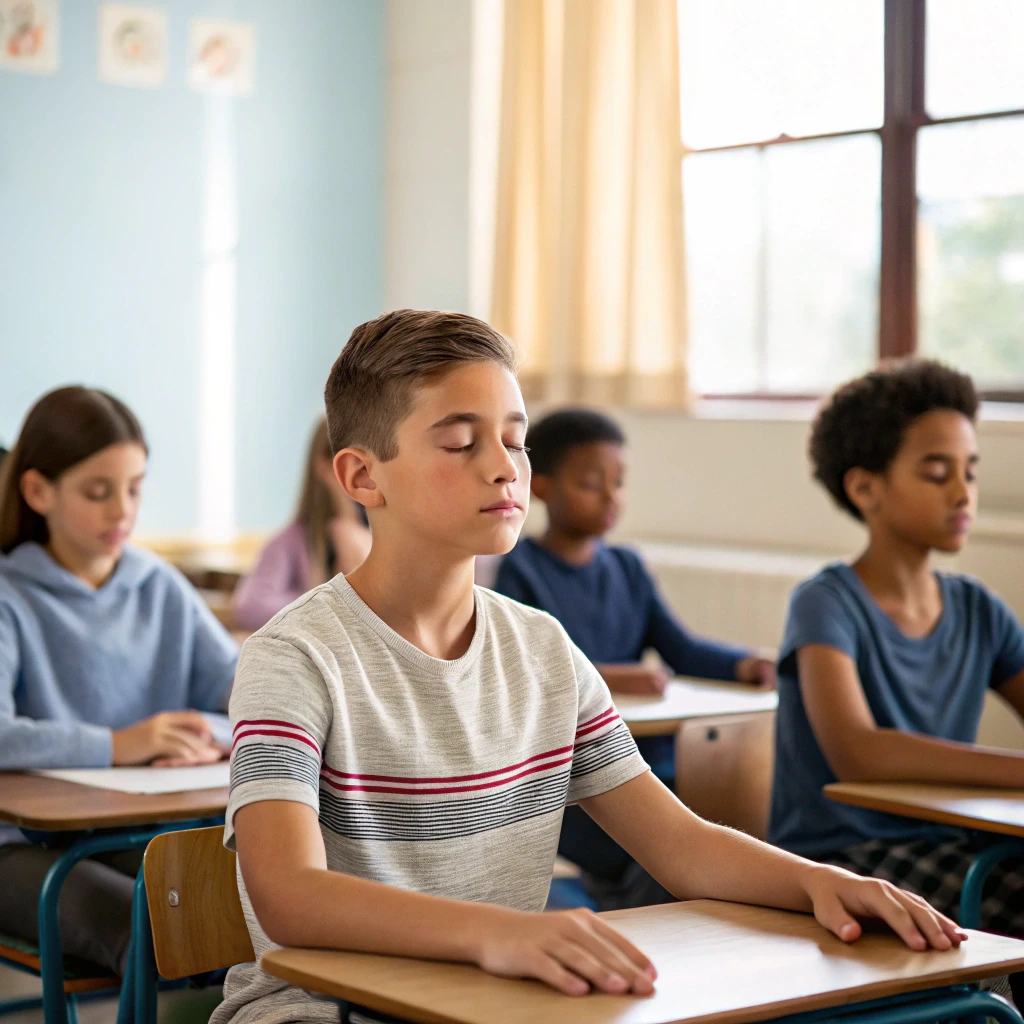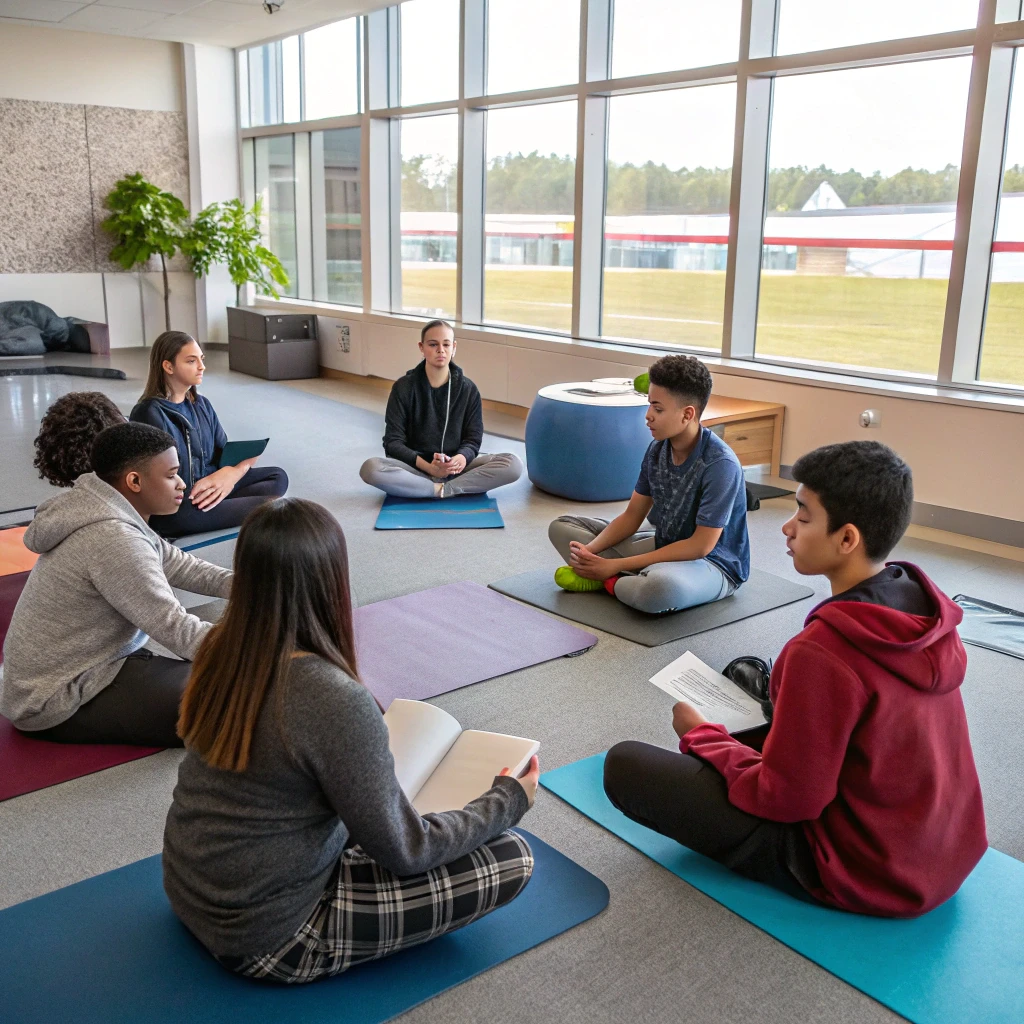
Mindfulness for Children: Age-Appropriate Techniques
Discover age-appropriate mindfulness techniques for children from preschoolers to teenagers, helping them develop emotional regulation, focus, and resilience.
Table of Contents
Why Teach Mindfulness to Children?

The Power of Early Mindfulness
Mindfulness equips children with valuable tools for navigating life's challenges. In today's fast-paced world, children face numerous stressors that can impact their mental wellbeing. By introducing mindfulness early, we provide them with skills that support emotional development and resilience throughout their lives.
Cognitive Benefits
Research shows that mindfulness practices can enhance children's focus, attention span, and memory. These cognitive improvements often translate to better academic performance and problem-solving abilities. Regular mindfulness practice helps children develop the mental clarity needed to navigate complex learning environments.
Emotional Wellbeing
Mindfulness helps children recognize and regulate their emotions. By learning to observe feelings without immediately reacting, children develop emotional intelligence that serves them throughout life. This awareness creates space between emotions and actions, allowing for more thoughtful responses to challenging situations.
Note for Parents and Educators: Children's mindfulness practices differ significantly from adult approaches. They should be playful, engaging, and age-appropriate. The techniques in this guide are designed to meet children at their developmental level while introducing core mindfulness concepts in accessible ways.
As we explore mindfulness techniques for different age groups, remember that consistency is more important than duration. Brief, regular practice yields better results than occasional longer sessions. Adapt these suggestions to fit your child's unique personality and interests, and don't hesitate to make the practices playful and fun.
Key Benefits of Mindfulness for Children
- 1Stress and anxiety management
Provides tools to calm the nervous system and reduce worry
- 2Enhanced focus and attention
Improves concentration and reduces distractibility
- 3Improved emotional regulation
Helps children recognize and manage difficult emotions
- 4Development of empathy and compassion
Fosters understanding of others' feelings and perspectives
- 5Better social skills
Improves communication and relationship-building abilities
Mindfulness for Preschoolers (3-5 years)
Young children benefit from playful, sensory-based activities that engage their imagination and natural movement. At this age, mindfulness should feel like play rather than practice.

Belly Breathing
This simple technique introduces children to mindful breathing in a playful way.
How to Practice:
- Have your child lie down on their back in a comfortable position.
- Place a small stuffed animal on their tummy.
- Ask them to breathe deeply and watch their stuffed animal rise and fall.
- Encourage them to focus on the sensation and movement for 3-5 breaths.
- Use phrases like "Watch your teddy go up and down" or "Make your teddy ride the waves of your breath."
Bubble Breathing
This activity combines breath awareness with the joy of blowing bubbles.
How to Practice:
- Provide your child with bubble solution and a wand.
- Demonstrate how to take a slow, deep breath in through the nose.
- Show them how to blow out slowly and gently to create bubbles.
- Encourage them to notice how their breath affects the size and number of bubbles.
- Invite them to watch the bubbles float away, bringing their full attention to the present moment.
Sensory Exploration
These activities help children develop present-moment awareness through their senses.
Ideas to Try:
- Sensory Bins: Fill containers with rice, beans, or water beads and encourage exploration with scoops and containers.
- Nature Walk: Take a slow walk outdoors, asking children what they can see, hear, smell, and feel.
- Emotion Stones: Use painted stones with different facial expressions to help children identify and talk about feelings.
- Texture Hunt: Collect items with different textures and have children describe how each feels.
- "Fly Like an Eagle": Combine slow walking with deep breathing, imagining they are soaring birds.
Preschoolers in Practice

Children practicing mindfulness in a group setting with a teacher
Expected Benefits for Preschoolers
- •Improved body awareness and sensory integration
- •Enhanced emotional recognition and vocabulary
- •Development of basic attention and focus skills
- •Calmer responses during transitions or challenging moments
Early Primary School (6-8 years)
Children in this age group can handle more structured mindfulness exercises that focus on emotional regulation and self-awareness. Their growing cognitive abilities allow for slightly longer practice sessions and more complex concepts.

Mindful Breathing with Shapes
This technique uses visual cues to guide children's breathing, making the abstract concept more concrete.
How to Practice:
- Draw a simple shape like a star, square, or triangle on paper.
- Have the child trace the shape with their finger while breathing.
- Instruct them to breathe in while tracing up or along one side.
- Then breathe out while tracing down or along another side.
- Continue around the entire shape, coordinating breath with movement.
- Encourage them to notice how their body feels during and after the exercise.
Glitter Jars
This activity provides a visual metaphor for how our minds can become calm after being stirred up.
How to Create and Use:
- Fill a clear jar or bottle with water, a few tablespoons of glitter glue, and some fine glitter.
- Seal it tightly and shake it to mix the contents.
- Explain to children that the glitter represents thoughts and feelings when we're upset or excited.
- When the jar is shaken, it's hard to see through—just like when our minds are full of swirling thoughts.
- As the glitter settles, our minds can also become calm and clear.
- Have children focus on watching the glitter slowly settle while taking deep breaths.
Mindful Eating
This practice helps children slow down and fully experience their food with all their senses.
How to Practice:
- Choose a small piece of food like a raisin, slice of fruit, or small biscuit.
- Guide children to examine it closely, noticing its color, shape, and texture.
- Have them smell the food and notice any aromas.
- Ask them to place it in their mouth without chewing at first, noticing how it feels.
- Encourage slow, deliberate chewing, paying attention to flavors and textures.
- Discuss the experience afterward: What did they notice that they usually don't?
Gratitude Practice
Encourage children to share one thing they are thankful for at bedtime or during class. This helps shift focus to positive aspects of life and develops appreciation. Create a "Gratitude Jar" where children can add notes about things they're grateful for, then read them together at the end of each week.
Good Morning Meditation
Start the day with a short breathing exercise to set a positive tone. Have children sit comfortably, close their eyes, and take five deep breaths while thinking of something they're looking forward to that day. This creates a calm transition into the day's activities and helps establish a mindfulness routine.
Expected Benefits for Early Primary
- •Increased focus and attention span in classroom settings
- •Better self-regulation of emotions during challenging situations
- •Improved classroom participation and social interactions
- •Development of gratitude and positive outlook
Early Primary in Practice

Early primary school children practicing mindfulness outdoors with a teacher
Older Primary School (9-11 years)
At this stage, mindfulness can include more introspective practices that encourage reflection and stress management. Children this age have developed greater self-awareness and can engage with more sophisticated mindfulness concepts.

Guided Imagery
This technique uses imagination to create calming mental experiences, helping children develop visualization skills.
How to Practice:
- Have children sit or lie down comfortably in a quiet space.
- Guide them to close their eyes and take several deep breaths.
- Lead them through visualizing a peaceful scene like a beach, forest, or meadow.
- Include sensory details: "Feel the warm sand beneath your feet... Hear the gentle waves..."
- Encourage them to create their own "safe place" they can visit in their mind when feeling stressed.
- After 3-5 minutes, guide them to slowly return their awareness to the room.
Yoga Poses
Simple yoga poses combine mindful movement with breath awareness, promoting body-mind connection.
How to Practice:
- Choose 3-5 simple poses appropriate for children, such as Mountain Pose, Tree Pose, or Warrior Pose.
- Demonstrate each pose, emphasizing proper alignment and safety.
- Guide children to focus on how their body feels in each position.
- Encourage them to coordinate their breath with the movements.
- For Tree Pose: "As you balance on one foot, imagine you're a strong tree with roots growing deep into the ground."
- Hold each pose for 3-5 breaths before transitioning to the next.
Mindful Journaling
Writing provides a structured way for children to reflect on their thoughts and feelings.
How to Practice:
- Provide children with a special notebook dedicated to mindfulness journaling.
- Set aside 5-10 minutes for regular journaling practice.
- Offer prompts appropriate for this age group, such as:
- "Three things I noticed today that made me smile..."
- "When I felt [emotion], my body felt..."
- "Something challenging that happened and how I handled it..."
- "If my feelings had colors, today they would be..."
- Emphasize that there are no "right" answers and spelling/grammar don't matter.
- Allow children to share from their journals only if they choose to.
Sound Meditation
Have children sit comfortably with eyes closed. Ring a bell or play a single note on an instrument, asking them to raise their hand when they can no longer hear the sound. Alternatively, guide them to listen carefully to all the sounds in their environment, from closest to farthest away. This practice enhances present-moment awareness and auditory attention.
STOP Method
Teach children this acronym for managing stressful moments:
S - Stop what you're doing
T - Take a breath
O - Observe how you're feeling
P - Proceed mindfully
This simple technique helps children pause and reset before reacting impulsively.
Expected Benefits for Older Primary
- •Enhanced ability to manage stress and anxiety
- •Improved concentration and academic performance
- •Greater emotional intelligence and empathy
- •Development of self-reflection and metacognitive skills
Older Primary in Practice

Older primary school students practicing mindfulness in a classroom setting
Adolescents (12+ years)
Teenagers benefit from mindfulness practices that promote introspection and coping strategies for complex emotions. These techniques acknowledge their growing independence and need for peer connection while providing tools for managing stress.

Body Scan Meditation
This practice helps teens develop awareness of physical sensations and release tension.
How to Practice:
- Have teens lie down or sit comfortably in a quiet space.
- Guide them to close their eyes and take several deep breaths.
- Direct their attention to different parts of the body, starting from the toes and moving upward.
- For each area, invite them to notice any sensations: tension, relaxation, temperature, tingling, etc.
- Encourage them to breathe into any areas of tension, imagining the breath softening those spots.
- Remind them that the goal isn't to change anything, just to observe with curiosity.
- The full practice can last 10-15 minutes for teens with practice.
Mindful Movement
These practices combine physical activity with present-moment awareness, appealing to teens' need for movement.
How to Practice:
- Mindful Walking: Guide teens to walk slowly, paying attention to each step. Have them notice the sensation of their feet touching the ground, the movement of their legs, and their balance shifting.
- Tai Chi or Qigong: These gentle movement practices combine breath with flowing motions. Even simple sequences can help teens connect with their bodies while calming their minds.
- Mindful Stretching: Lead teens through gentle stretches, encouraging them to notice the sensations in their muscles and joints without pushing beyond comfortable limits.
- Emphasize that these practices aren't about performance or achieving specific poses, but about bringing full awareness to movement.
Visualization Exercises
These techniques harness teens' imagination to manage stress and build confidence.
How to Practice:
- Future Success: Guide teens to visualize themselves successfully completing a challenging task or achieving a goal. Have them include sensory details and the positive emotions they'll feel.
- Safe Place: Invite teens to create a detailed mental image of a place where they feel completely safe and calm. This can be a real or imagined location.
- Wise Mentor: Have teens imagine meeting a wise, compassionate figure (real or fictional) who offers them guidance about a current challenge.
- Encourage teens to practice these visualizations independently before tests, performances, or stressful situations.
Gratitude Journals
Encourage teens to keep a journal where they regularly record things they're grateful for. This practice helps counterbalance the negativity bias that can be especially strong during adolescence. Suggest they write three things they appreciate each day, being as specific as possible. Research shows that gratitude practices can significantly improve mood and outlook.
Peer Group Activities
Mindfulness practiced in groups can be particularly effective for teens, who value peer connection. Consider creating a mindfulness club at school or organizing group sessions where teens can practice together. Group discussions after mindfulness exercises allow teens to share experiences and normalize the challenges of maintaining focus.
Expected Benefits for Adolescents
- •Reduced stress and anxiety during academic pressure periods
- •Improved emotional regulation during hormonal changes
- •Enhanced focus and concentration for academic success
- •Development of healthy coping mechanisms for life challenges
Adolescents in Practice

Adolescents practicing mindfulness techniques in a high school setting
Practical Tips for Parents and Educators
Successfully introducing mindfulness to children requires thoughtful implementation and consistency. These practical strategies will help you create an environment where mindfulness can flourish.

Model Mindfulness
Children learn by observing adults. When you practice mindfulness yourself, you not only receive the benefits personally but also show children that these practices are valuable and normal. Be transparent about your own mindfulness journey, sharing both successes and challenges in age-appropriate ways.
Practical Ideas:
- Practice mindful breathing when children can observe you, explaining what you're doing.
- Narrate your own use of mindfulness in daily situations: "I'm feeling frustrated, so I'm taking some deep breaths to calm down."
- Share how mindfulness helps you: "I was worried about my meeting today, so I did a quick meditation that helped me feel more confident."
- Invite children to join your practice rather than forcing participation.
Make It Fun
Children engage more deeply with activities they enjoy. By incorporating playfulness, creativity, and imagination into mindfulness practices, you can make them more appealing and effective. The goal is to create positive associations with mindfulness that will encourage continued practice.
Engaging Activities:
- Use storytelling to guide visualizations: "We're going on a journey to a magical forest..."
- Incorporate favorite characters: "How would Spider-Man take calm, powerful breaths?"
- Try mindful coloring with mandalas or calming scenes.
- Create mindfulness games like "Mindful Simon Says" or "Freeze Dance" with awareness of sensations when stopping.
- Use props like stuffed animals, glitter jars, or chimes to make practices more tangible and interesting.
Keep It Short
Children's attention spans vary by age and individual temperament. Starting with brief sessions increases the likelihood of success and positive experiences. As children develop their mindfulness "muscles," they can gradually engage in longer practices.
Age-Appropriate Durations:
- Ages 3-5: 1-3 minutes
- Ages 6-8: 3-5 minutes
- Ages 9-12: 5-8 minutes
- Ages 13-18: 8-15 minutes
- Always prioritize quality over quantity—a fully engaged 2-minute practice is more beneficial than a distracted 10-minute session.
- Watch for signs of restlessness or disengagement and adjust accordingly.
Integrate into Daily Routines
Embedding mindfulness into existing routines makes it more sustainable and helps children associate mindfulness with daily activities. Consider these natural integration points:
- Morning: A brief breathing practice to start the day
- Mealtimes: Mindful eating for the first few bites
- Transitions: A moment of stillness between activities
- Bedtime: Body scan or gratitude practice
- Nature walks: Mindful awareness of surroundings
Be Patient
Mindfulness is a skill that develops over time. Children may initially struggle with sitting still or maintaining focus, which is completely normal. Approach the process with patience and a growth mindset:
- Acknowledge and praise effort rather than "perfect" practice
- Normalize wandering attention: "Minds are made to think, and that's okay"
- Avoid criticism when children struggle with mindfulness
- Share your own challenges with maintaining focus
- Celebrate small improvements and moments of engagement
Additional Considerations
- •
Respect individual differences: Some children may respond better to movement-based practices, while others prefer quiet reflection. Offer variety and allow children to gravitate toward what works for them.
- •
Create a dedicated space: If possible, designate a quiet corner or area for mindfulness practice with comfortable seating, minimal distractions, and perhaps calming visual elements.
- •
Use age-appropriate language: Adjust your vocabulary to match children's developmental level. For younger children, use concrete terms and simple metaphors; for older children, you can introduce more nuanced concepts.
- •
Consider cultural context: Be sensitive to how mindfulness practices might be perceived within different cultural or religious backgrounds, and adapt terminology if needed.
Conclusion
Mindfulness offers lifelong benefits when introduced early in development. By tailoring techniques to children's age groups, parents and educators can create engaging experiences that nurture emotional growth, resilience, and well-being.
Key Takeaways
- 1
Start early and adapt as children grow: Begin with simple, playful practices for young children and gradually introduce more complex techniques as they develop.
- 2
Consistency matters more than duration: Brief, regular practice creates more lasting benefits than occasional longer sessions.
- 3
Model what you teach: Children learn mindfulness most effectively when they see it practiced by the adults in their lives.
- 4
Make it engaging and relevant: Connect mindfulness to children's interests and daily experiences to increase motivation.
- 5
Celebrate progress: Acknowledge growth in mindfulness skills, however small, to encourage continued practice.
The journey of teaching mindfulness to children is both rewarding and challenging. As you introduce these practices, you're not only helping children develop valuable skills for managing their current experiences but also equipping them with tools they can use throughout their lives.
Remember that mindfulness is not about achieving perfect stillness or concentration—especially for children. It's about cultivating an attitude of curiosity, kindness, and present-moment awareness that can transform how they relate to themselves and the world around them.
As children grow in their mindfulness practice, they develop greater emotional intelligence, resilience in the face of challenges, and capacity for compassion—skills that will serve them well in all aspects of life, from academic achievement to personal relationships and mental wellbeing.
A Lifelong Gift
"Teaching children mindfulness is like planting seeds in a garden. With patience, consistent care, and the right conditions, these seeds will grow into strong, resilient plants that can weather life's storms. The mindfulness skills children develop now will continue to flourish throughout their lives, supporting their wellbeing long after childhood has passed."
By exploring the age-appropriate techniques in this guide and adapting them to suit the unique needs and interests of the children in your care, you're offering them one of the most valuable gifts possible: the ability to be present with their experiences with awareness, acceptance, and compassion.
Further Resources

Headspace for Kids
Guided meditations designed specifically for children of different age groups.
Visit ResourceMindfulness in Schools Project
UK-based charity teaching mindfulness to students and educators.
Visit ResourceBBC Good Food - 10 Mindfulness Exercises for Kids
Simple mindfulness activities to try at home.
Visit ResourceNHS - Mental Health for Children
NHS resources on supporting children's mental wellbeing.
Visit Resource